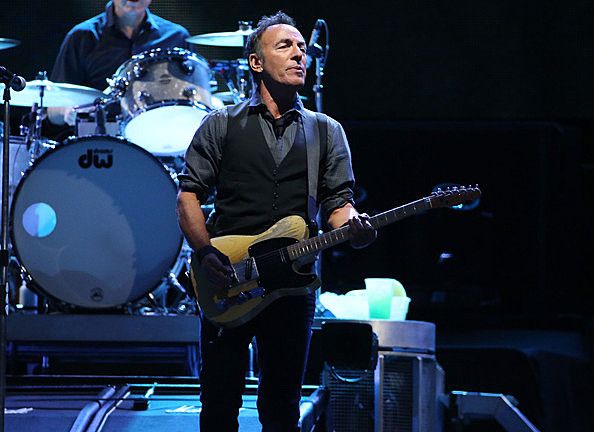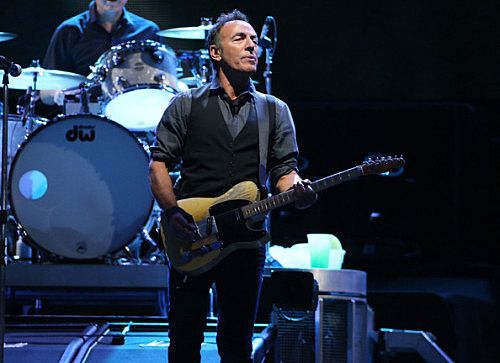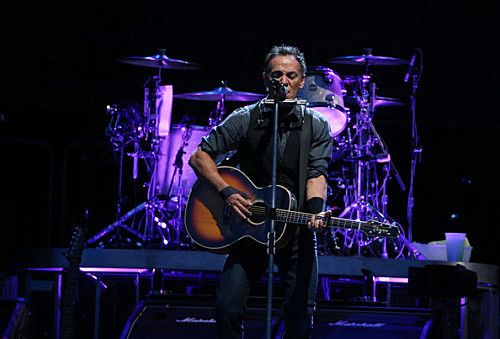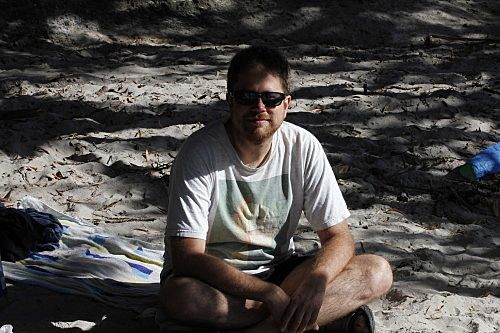Review: Bruce Springsteen and The E Street Band
Doug Dillaman reviews Bruce Springsteen and the E Street Band, 1 March 2013, Auckland.
- 1 March 2013, Auckland -
He takes the stage, alone, holding an acoustic guitar, still looking like a workingman’s hero. The heaving crowd – aged, full of possibly ironic bandanas, impossibly white — cheers, then quiets. How will he start? It’s a safe guess he’ll play a song about being on the wrong side of the economic spectrum, being disaffected, maybe with some entreaties to desperate romance as a method for escaping misery; it’s what he traffics in. And that’s what he does. But not the way we’re guessing.
It was a shock then, but anyone who cares now knows that that song was Lorde’s “Royals”. And many of those who have heard the version he performed from the comfort of their home have been summarily unimpressed. But it’s impossible to overstate how galvanizing it was to hear live, unheralded and unexpected, discovered in real time. Of course, any A-lister performing “Royals”, from Beyonce to U2, would have evoked a surge of nationalist audience pride. But for me, the impact isn’t borne of patriotism (being an expat American myself), but of how his choice of cover concisely represents the inclusive spirit that permeates his music.
There’s room for a 21st century electro-pop anthem, there’s room for gospel, there’s room for traditional Irish sounds — hell, there’s room for between song drones that briefly evoke Sigur Ros. It’s all rock and roll to Bruce. There’s also room for Tom Morello, the guitarist of Rage Against The Machine, who’s all over High Hopes, the latest record, and has joined the already heavingly large (like, five guitars large) E Street Band. The low stage makes it near-impossible from our standing vantage to calculate how many are on stage or what they’re holding at any given time, as we increasingly rely on video screens that focus on a single person. It’s only at the end of one song that I look to the stage and notice, for instance, a band member is playing a tuba.
Tubas, accordions, African hand drums, gospel choirs: it all sounds like something more suited for WOMAD. But, unlike, say, Paul Simon or Peter Gabriel, it never feels that contrived or premediated. What makes Springsteen is his ear for how all these disparate elements and influences can be united under one tent – an incredibly large one, but The Boss is a big-hearted guy, so we know he’ll make room for everybody he can see a connection with, and we know he’ll try to find a connection with everybody.
He’s done his level best to include everybody offstage as well, and not just with a multi-tier stage that dives so deep into the audience as to render him invisible from beyond the front row in some songs. Unusual to my experience, the video screens feature not just shots of the band and shots of the audience (who get as much lighting attention as the band), but angles from the back of the stage that face back out to the audience, merging band and audience into a single striking visual.
And there’s a lot to see. Springsteen’s famous for playing audience requests, including songs his band may not have played for years, and the front rows are heaving with fans holding signs, which become a constant reminder of the depth of his catalogue and posit a multiverse of alternate setlists. We never get to hear Springsteen play “My City In Ruins” for Christchurch – that winds up happening the following night - but the sign means we imagine it, and in its own way that’s enough. Instead, he picks a sign up for “Loose Ends”, a track I’ve never heard (which, it transpires, is off Tracks) and that reveals itself to be as essential and sad as anything I’ve heard from Bruce. Pity that the sound at Mt. Smart is a bit shit, the wind playing havoc and making everything a bit muddy, but the fragmentary received lyrics still capture the same spirit of, say, “Brilliant Disguise”, another song we’re reminded of by a sign that we never hear.
[caption id="attachment_8815" align="aligncenter" width="500"] Photo: Fiona Goodall/Getty Images AsiaPac[/caption]
Springsteen’s earlier song selections generally veer towards the disaffected and sad, and while hearing the key lyrics of “The River” –
Now those memories come back to haunt me,
They haunt me like a curse
Is a dream a lie if it don't come true
Or is it something worse
- can’t help but be a resonant, powerful experience, especially as the blue light bathes audience members who, lost in their own reverie, sing along and are surreptitiously projected onto the video screen, there’s also something that feels missing. I mention to my friend that “it’s more angry Bruce than sexy Bruce”, and think of the foxy devil who pulled Courtney Cox into stardom, oh so many years ago, who seems to be absent tonight.
Turns out he’s just lying in wait. After a relatively somber hour – a terrific hour, mind – Bruce announces that he’s going to play “Born In The USA” from top to bottom. The crowd goes wild, the drums and 80’s keyboard kick in, and in no time at all I’m surrounded by the perplexing sensation of 40,000 odd Kiwis, a people known for their reflexive America-bashing, singing the refrain “I was born in the USA”. Was it strange to Springsteen? Probably not. They – we - have bought into the collective delusion that, despite his wealth and fame, he’s a voice of the working man, so why should this equally plausible audience claim seem any stranger? Besides, he’s inclusive. And he’s loving this, and sexy Bruce has indeed taken center stage.
By the time “Darlington County” rolls around, Bruce has taken advantage of the split-level stage design to not just get close to the audience but is actually IN it. He’s leaning on the folks in the front row, letting them sing the “na na na” bit, and he’s in heaven. It reminds me of something The Hold Steady say every night on stage: “There is so much joy in what we do!” But Bruce doesn’t need to say it, because he and the band are living it, and through them living it, we experience it as well. And that’s the magic of the Springsteen persona: by us buying into the notion that he is an everyman, one of us, his joy can become ours, a connection that, say, Dylan or Bono (or Kanye or Madonna) could never hope to achieve.
But despite that, and the lucky woman who joins Bruce on stage for a “Glory Days” sing-along (and loses an ass-shaking contest to him in spectacularly embarrassing fashion), and the subsequent welcoming to the stage of many more fans for a giant “Dancing in the Dark” dance-a-thon, there’s more than joy. And it’s not just the sadness of the closing track of the album, “My Hometown”, which is dedicated to Christchurch, a perhaps obligatory but nonetheless lacerating moment for everybody. There’s also absence, an absence felt every time the sax man takes the stage. I don’t know who he is – I posit that he looks like Richard Aoyade, my friend counters with Rick Moranis – but both in stature and gravitas he’s nowhere near as giant as the sadly departed Clarence Clemons. Until the televisual adventures of guitarist Steven Van Zandt, he would easily been the most famous member of the band not named “Bruce Springsteen”, his distinctive figure and his ebullient joy a signature of so, so many Springsteen hits. And this young man with the sax is doing a great job, but some shoes can’t be filled, and for all the joy, I have to wonder what it’s like to continue on without the big man.
(It turns out the sax player is Clemons’ nephew, Jake Clemons, a fact that bigger fans probably already knew, and a fact that warms my heart: the E Street Band may be inclusive, but they’re also a family.)
[caption id="attachment_8816" align="aligncenter" width="500"] Photo: Fiona Goodall/Getty Images AsiaPac[/caption]
And then, after a quick parade of hits – and it is most certainly a parade, as the band just doesn’t stop, with somebody playing almost every moment of what now has probably been 2 hours and 45 minutes – anyway, hip-deep in what is called the encore, even though the band hasn’t left the stage, there’s the concentrated joy of “Tenth Avenue Freeze-Out”, and as I’m dancing to one of Bruce’s most soulful and fun songs ever, it gets to the top of the second verse, and Bruce says, “okay, this is the important part”.
And with that, the video screen, which up til then exclusively has used live footage from the event, switches to archive footage of Clarence and Bruce from their entire career, as well as of Danny Federici, another fallen E Street Band member. The song ends, and the screen fills with a final image of Clarence, the camera catches Bruce looking at his fallen bandmate, and I am reminded of the key principle of successful grieving. You continue because you have to, you continue because it’s what they would have wanted for you, and you can enjoy life – but still, you never forget.
That’s not the end. The Boss won’t let us leave with grief in our hearts, and the joyful conclusion he has in mind is a cover of “Shout”, by The Isley Brothers. It’s distended, glorious, super fun, and acts as a natural end point, connecting the throughline of the show from a song by one Pakeha girl from New Zealand in 2013 to three black brothers from America in 1959. It’s an eternal golden braid, woven together with so much musical fabric it would overwhelm a newcomer, but for a man who’s been at the frontlines for four decades (to say nothing of the deep fandom that preceded his career) it’s a natural vision. And after the song ends, and the bows are taken, he stands near the stage exit, giving high-fives to every band member. It takes ages, and people think the show is over.
The show is not over. There’s still a bookend to be had. Three hours later, he finishes as he starts, alone with an acoustic guitar and harmonica and his voice, with another song about the impossible distance between dreams and reality and the passion that burns within you when you’re with someone who is your only ally in forgetting that impossibility for a moment. For all the adulation, it never occurs to us in the moment that Bruce Springsteen is a man, fallen bandmates and messy divorce and all, who has come closer than any of us ever will to bridging that distance. We just sing along to “Thunder Road”.
And, with the exception of the guy who inexplicably yells out “Streets of Philadelphia!” partway through, we go on the ride, and imagine driving home, with anything possible. For a brief moment we think it might make sense to drive back here tomorrow, and come back to Springsteen’s tent, an inclusive place where everything, no matter how either or unexpectedly or inevitably tragic, feels a bit better because we’re sharing it. We’re all in it together.



